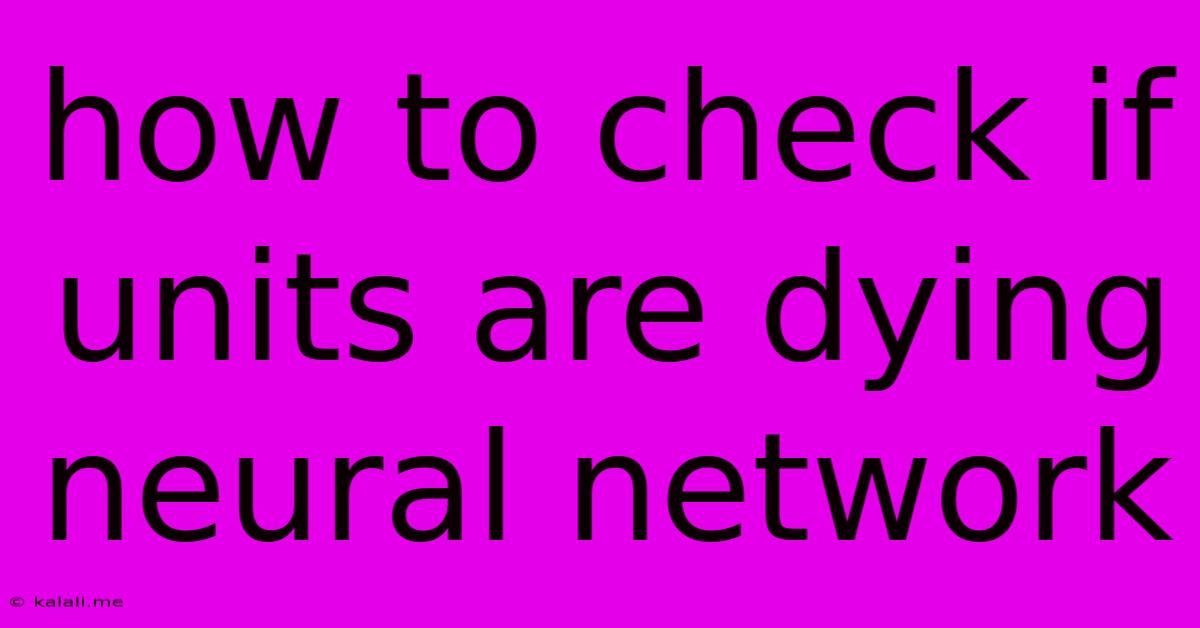How To Check If Units Are Dying Neural Network
Kalali
May 24, 2025 · 4 min read

Table of Contents
How to Check if Units are Dying in Your Neural Network
Detecting and addressing "dying units" – neurons in your neural network that cease to contribute meaningfully to the learning process – is crucial for building robust and effective models. These units become inactive, essentially "dying," and hinder the network's overall performance. This article explores various methods to identify and mitigate this common neural network problem. Understanding the root causes and implementing appropriate solutions can significantly improve your model's accuracy and efficiency.
What are Dying Units?
Dying units are neurons within a neural network's layers that consistently output values close to zero or a constant value regardless of the input. They essentially become inactive, failing to learn or contribute to the network's predictive capabilities. This can stem from various issues, including poor initialization, unsuitable activation functions, or learning rate problems.
Identifying Dying Units:
Several techniques can help pinpoint these underperforming neurons:
-
Monitoring Activations: The simplest approach involves observing the output activations of your neurons during training. If a neuron consistently outputs values close to zero or a constant throughout training, it's a strong indicator of a dying unit. Visualizing these activations (e.g., using histograms or plots) can help identify problematic neurons. Look for units with consistently low variance in their outputs.
-
Gradient Analysis: Analyze the gradients flowing through the network. Dying units will often exhibit extremely small or zero gradients, indicating a lack of influence on the loss function. This suggests these units aren't learning and aren't updating their weights effectively. Tools for visualizing gradients can be invaluable here.
-
Weight Inspection: Examine the weights associated with the dying units. Often, these weights will stagnate or remain close to their initial values during the training process. This lack of weight updates reinforces their inactivity.
-
Regularization Techniques: While not directly identifying dying units, techniques like dropout or weight decay can prevent them from occurring in the first place. If you see an improvement in model performance after implementing these, it suggests that dying units might have been a contributing factor.
Causes of Dying Units:
Understanding the underlying causes helps in choosing effective solutions:
-
Poor Weight Initialization: If weights are initialized too small, the gradients might become too small, hindering the learning process. Using appropriate initialization methods (e.g., Xavier/Glorot initialization or He initialization) can help.
-
Inappropriate Activation Functions: Certain activation functions, like sigmoid or tanh, can suffer from the vanishing gradient problem, where gradients become extremely small during backpropagation, leading to slow or stalled learning for certain units. ReLU (Rectified Linear Unit) or its variants are often preferred as they mitigate this issue.
-
Learning Rate Issues: A learning rate that's too small can result in slow weight updates, potentially causing units to stagnate. Conversely, a learning rate that's too large might cause the network to oscillate wildly, preventing convergence and potentially leading to units becoming unresponsive. Adaptive learning rate methods can help address this.
-
Data Issues: Insufficient or poorly scaled data can contribute to dying units. Ensure your data is preprocessed correctly (normalization, standardization), and consider data augmentation techniques to enhance the diversity of your training data.
Mitigation Strategies:
Several strategies can help address and prevent dying units:
-
Adjusting the Learning Rate: Using adaptive learning rate methods (e.g., Adam, RMSprop) helps adjust the learning rate dynamically, potentially reviving inactive units. Experiment with different optimizers to find what works best for your specific model.
-
Choosing Appropriate Activation Functions: ReLU or its variants (Leaky ReLU, Parametric ReLU) often outperform sigmoid and tanh due to their ability to mitigate the vanishing gradient problem.
-
Better Weight Initialization: Employing more robust weight initialization techniques like Xavier/Glorot or He initialization can help prevent weights from becoming too small.
-
Regularization: Techniques such as dropout and weight decay help prevent overfitting and encourage more diverse weight distributions, reducing the likelihood of dying units.
-
Batch Normalization: This technique normalizes the activations of each layer, preventing the vanishing/exploding gradient problem and potentially helping alleviate issues with dying units.
Conclusion:
Dying units are a significant problem in neural networks. By carefully monitoring activations, gradients, and weights, and by using appropriate techniques for weight initialization, activation function selection, and learning rate adaptation, you can effectively identify and mitigate the impact of dying units, leading to more robust and accurate models. Remember that thorough experimentation and careful analysis are crucial for identifying the specific causes and developing effective solutions within your own projects.
Latest Posts
Latest Posts
-
How To Remove Super Glue From Glass
May 24, 2025
-
How To Get Paint Off Hardwood Floors
May 24, 2025
-
Age Of Romeo In Romeo And Juliet
May 24, 2025
-
How Do You Know If Meat Is Bad
May 24, 2025
-
What Is A Natural Hat Trick
May 24, 2025
Related Post
Thank you for visiting our website which covers about How To Check If Units Are Dying Neural Network . We hope the information provided has been useful to you. Feel free to contact us if you have any questions or need further assistance. See you next time and don't miss to bookmark.